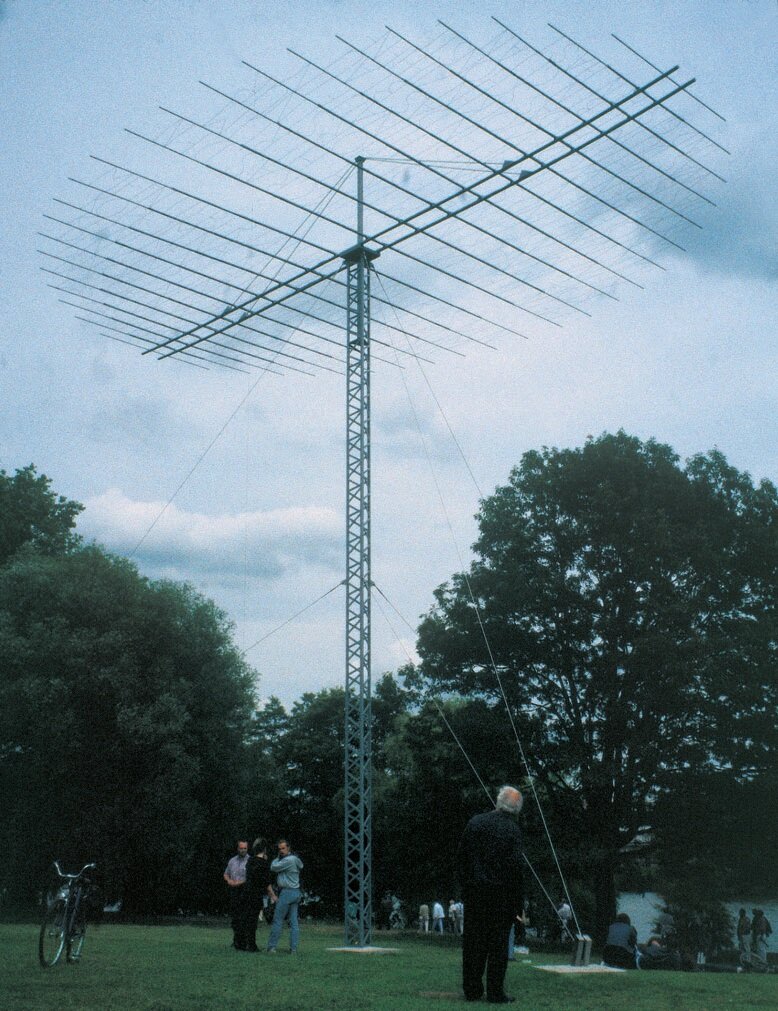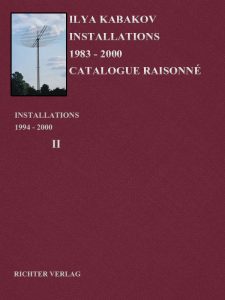Looking up. Reading the Words...
YEAR: 1997
CATALOG NUMBER: 111
PROVENANCE
The artist
Collection city of Münster
EXHIBITIONS
Münster
Skulptur. Projekte in Münster 1997, 22 Jun 1997 — 28 Sep 1997 (Organization: Westfälisches Landesmuseum für Kunst und Kulturgeschichte, Münster)
Münster
Permanent installation, 1997
DESCRIPTION
Technical Description
The installation represents a metal steel construction consisting of a mast and 22 metal ‘antennas’ attached to its top, between which thin (3mm) metal letters are welded.
The mast (13meters in height) is three-sided. The width of each side is 45cm. It is secured below on a cement block (20 cm above the ground).
On the very top of the mast, two aluminum pipes are secured (40 cm in diameter), the length of each is 14.45 meters. They serve as the support for the pipes of ‘antennas’ lying perpendicular on them. These aluminum pipes ‘lie’ parallel. The distance between them is 45 cm. They are ‘tightly’ fastened to the top area of the mast to prevent them from turning.
Twenty-two ‘antennas’ of various lengths are attached to these pipe-supports. They are sectional (see sketch), and in the middle section, there are pipes inserted (screwed) into one another. At the ends, there are ordinary rods, 2cm thick. The distance between them is greater toward the center of the construction and smaller toward the edges (see sketch).
Letters are secured between the pipes of the ‘antennas.’ They are made of metal wires 3mm in diameter and are attached to the antennas either with the help of welding or with screws. Since the wind might cause the ‘antennas’ to sway, the attachment of the letters to them must be thoroughly considered as a separate task.
The attachment of the mast and the ‘antennas.’ The mast is secured by 6 bracing wires which run to the cement columns, and that are anchored into the earth at a distance of 10 meters from the mast. Three extension wires (8mm in thickness) run from the top of the mast, 3 run from its center. The ‘antennas’ are secured with two such extension wires as well so that the support on which they are attached does not bend. For this a vertical beam (2meters in height) is attached to the top of the mast, and 2 extension wires run from it and are secured to the supports of the ‘antennas’ so that they cannot bend and so that they remain constantly in a horizontal state.
CONCEPT OF THE INSTALLATION
1- In an open place, not far from a river where the slightly hilly shore in the summer is covered with grass and where there are not too many people around, a metal construction is erected which is similar in appearance to a radio antenna that gives and receives signals. When the viewer approaches closer to it and looks at it from bottom to top, he notices with surprise how barely visible letters that combine into words are arranged between the ‘feelers’ of the antennas. If you muster your attention, you can read an entire text:
“My Dear One! When you are lying in the grass, with your head thrown back, there is no one around you, and only the sound of the wind can be heard and you look up into the open sky – there, up above, is the blue sky and the clouds floating by – perhaps this is the very best thing that you have ever done or seen in your life.”
The entire ‘essence’ of the installation is achieved by the thickness of the lines which form the letters and the entire written text. The thickness of these lines (the wire is 3mm in diameter) is such that, against the background of the sky at a distance of 13 meters from the ground, they create the effect of a unique twinkling: ‘I see – I don’t see.’ (A similar effect emerges when looking at a spider web stretched across branches in the forest.) That is, given a certain effort of vision, we can read the written text, but without this effort, it could seem that it doesn’t exist at all. The text seems to appear before our eyes and then dissolve against the background of the sky.
But it is precisely this twinkling as we try to make out the text that coincides with the ambiguity of the meaning of this text, which can also be perceived as a vision, a mirage arising before us.
Always, whenever we look up at the sky, we involuntarily have a presentiment. Unconsciously we anticipate some sort of ‘communication’ from there. It seems to us that something is occurring there, in the cosmos, in its infinite heights.
But it would be strange to anticipate that this ‘something’ would be addressed directly to me, that a personal contact might be established specifically with me.
But this is precisely what seems to be happening to my unbelieving eyes. In some strange way, the enormous screen of an antenna has received this ‘information’ and is passing it on to me, for me, as I stand below, having raised my head up. But, I would like to repeat once again, this effect of the strangeness and unexpectedness of the address emerges only when one’s consciousness and eyes are not entirely certain that they have actually discerned something at a great height against the background of the sky and white clouds.
2- The reason why the idea for such an installation was selected in this place rests in the general topography of that region of Munster, and, more precisely, the proximity along the same shoreline to a beautiful sculpture of Donald Judd. In all of its construction, Judd’s work is turned upward, to the sky. When standing next to it, one’s glance involuntarily raises upward, and a connection between the earth and sky occurs in this place thanks to the work of a great artist. Under the impression of this work, I would like to repeat the same theme, since the shoreline surrounding the landscape and the very aura of the place remains one and the same for a great distance.
3- There is one more, you could say, ‘game’ element to the proposed installation. The radio antenna is sort of a synonymous image, a symbol of our technical civilization, of its interminable ‘progress.’ This is a means for conveying ‘information’ to the entire earth and, in turn, receiving it from everywhere, information the volume of which increases with each year, and, as everyone knows, increases all human potential. The proposed installation, its entire ‘pathos,’ consists precisely in disconnecting ourselves from this ‘wind’ of civilization, remaining alone with ourselves and with nature, hearing the sound of a different wind.
The fact that this symbol of communication – an antenna – strays from its usual function, causes it to cease being an instrument for that communication, and, on the contrary, it becomes only a prop, a frame, for simple human words. So you can also read it as a unique symbol, in part a ‘protest,’ uttered in such an ironic, ‘playful’ form.
Images
Literature











